Saturday, June 8th 2013
We have a global membership card allowing us entry to all the Royal palaces that are open to the public and we today we decided to visit Kensington Palace. Long ago, Kensington was a small village surrounded by fields, a quiet place, remote from the hurly burly of London. In 1610 (some say 1605), Sir George Coppin built a Jacobean manor house there. The house came into the possession of the Earl of Nottingham and became known as Nottingham House.
The so called “Glorious Revolution” pushed James II off the throne and replaced him with joint monarchs William and Mary. In 1689, looking for a quiet setting for their private home, the Royal pair bought Nottingham House from Daniel Finch, 2nd Earl of Nottingham, and commissioned Christopher Wren to turn it into a Royal residence. The Palace has continued to be a Royal residence until the present day but the state apartments gradually fell into disuse. After restoration work, some of the apartments were opened to the public in 1899, and a further section followed in 1912, originally as the location of the London Museum. Damage was done by bombs in the Second World War but after careful repair and reconstruction, the public parts can be visited, along with the gardens, once private to the Palace but now a public park. For a brief history of Kensington Palace, see here.

Cabmen’s Shelter
One of 13 survivors
The bus brought us to Kensington Road where we encountered one of the 13 surviving cabmen’s shelters. Nowadays, these generally also sell refreshments to the public (though only cabbies are allowed to sit inside) but this one was closed. In fact, I have yet to find one open.

Kensington Gardens
A path among flower beds
We entered Kensington Gardens, which cover a large expanse and contain a mixture of environments, including flower beds and open areas. There is water in the form of the Round Pond and a narrow lake called the Long Water. This, together with Exhibition Road, separates Kensington Gardens from Hyde Park. Beyond the bridge, the lake takes the better known name of the Serpentine. (See map.)

Roller skis
Doing it the hard way?
As well as pedestrians (including joggers), the park is open to bicycles and to these strange devices called roller skis. In my opinion, it is a bad principle to mix bicycles and pedestrians and I am sorry to see the habit spreading. However, I was intrigued by the roller skis, whose use, it seems to me, amounts to using the park the hard way. It’s one thing for them to coast down a slope with their ski sticks tucked under their arms and quite another to see them struggling to push themselves up even a gentle hill. Judging by the embarrassed expressions of those I photographed, perhaps they too were beginning to see the absurd side of it.


Esmé Percy Fountain
By Sylvia Gilley (1961)
Near the gate is a decorative fountain, though I am not sure whether it works or what it does. It is topped by a lively sculpture of a small dog who looks as if his is inviting his human companion to play a game. Inaugurated in 1961, it is by sculptor Sylvia Gilley and is in honour of the largely forgotten actor and producer, Saville Esmé Percy (1887-1957).


Palace Gates
Decorated with gilt work
As you approach Kensington Palace, you see this rather fine gateway, with gilt decorations, sparkling in the sun. The effect is somewhat spoilt at the moment by the scaffolding behind it but that is certainly temporary. Once the scaffolding has gone, who will be allowed to enter through these gates? I doubt whether we commoners will be granted that privilege.

Public entrance
Diamond Jubilee Canopy
The entrance for the likes of us is around the side, not quite the tradesman’s entrance but probably a purpose-built door in what was once one of the ground floor rooms. You pass under a canopy erected in honour of the Diamond Jubilee of the present Queen, a solid piece of ironwork that looks as if it might have been dreamed up by I.K. Brunel during a nightmare after a bad Chinese meal.
You are offered four tours: The King’s State Apartments, The Queen’s State Apartments, Victoria Revealed and Modern Royals. By “tour” is meant a sign-posted path through the rooms concerned. We started by following tour 3, Victoria Revealed. I must say that I found the whole experience a little disappointing. There are exhibits, yes, and information panels on the wall, yes, and the occasional video and audio commentary, but none of this needs to be in Kensington Palace. It could all be moved to some other venue without any loss. In other words, you get no feeling of what it was like to visit the Palace when Victoria was in residence or what it would have been like to live there.


Black Dress
Worn at Victoria’s first Privy Council meeting
Photography is allowed (without flash) and, rather than try to recount the tour, which would be rather tedious for both you and me, I will show you a few items that I photographed along the way. Above is the black dress worn by the new Queen Victoria at her first Privy Council meeting. It is a mourning dress as she was still in mourning for her uncle, William IV. You may wonder at the description “black dress”: originally black, the dress has turned brown because of the instability of the dye.

Prince Albert’s Wedding Suit
(Modern reproduction)
Unlike some Royal couples we could mention, Victoria and Albert made a true love match. Albert was to work tirelessly in the service of his adopted country – and some say the strain contributed to his early death – and I do not think that his contribution has been valued as it should, even now when historians have had time to assess his life. If this suit is an accurate reproduction then, by own standards, he was a man of small stature.

Wedding dress
Worn by Victoria when she married Albert
Wedding dresses remain some of the most elaborate dresses worn by women in our own day but we are unlikely to find anything quite as full and heavy as a Victorian wedding gown.
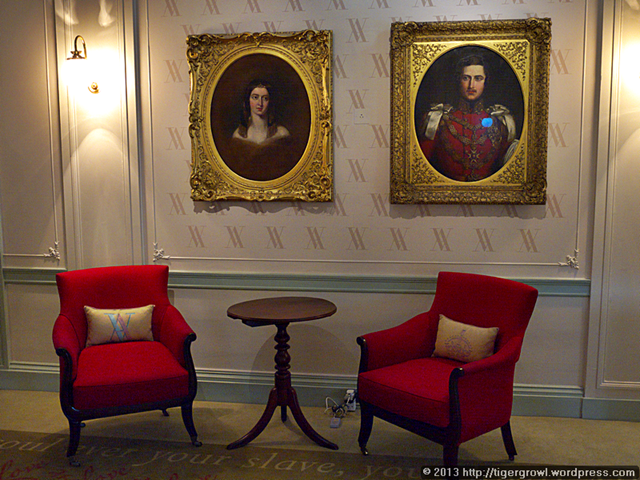
Seats for visitors
Under portraits of Victoria and Albert
Feeling a little tired from rambling around the palace? There are a few seats for visitors, such as this pair under the watchful gaze of Victoria and her Prince Consort.

Winged Victory
Bought at the Great Exhibition
One of the most prominent domestic events during the reign of Queen Victoria was the Great Exhibition in 1851. It was largely inspired and produced by Prince Albert and the Royal couple were closely associated with it. The above sculpture of Winged Victory by Christian Daniel Rauch, was bought by Victoria at the Exhibition as a gift for Albert. It is a smaller version of a seven-foot sculpture which she also bought.

Cradle
Made for Princess Louise
As well as buying items from the Exhibition, Victoria and Albert also contributed exhibits. One of these was a cradle made for Princess Louise. Victoria had asked for it to reflect the design of cradles she had seen in Italian and Flemish paintings and it also incorporated the coats of arms of the Royal families of Britain and Saxe-Coburg-Gotha. The designers and makers did a good job: the cradle received two prize medals at the Exhibition.

Bust of Albert
Appears in many photographs of Victoria and her family
One of the more atmospheric pieces on show is a bust of Prince Albert. Looking at it, I almost felt as if I were in the presence of the man… or his ghost. Perhaps it is the air of reverie that makes him look as though he is physically here but already far away in thought and mind. Victoria commissioned it shortly after the death of the Prince and it seems to have become a sort of totem or place-holder for the man.

Family photograph
The bust stands in for Albert
After Albert’s death, the bust seems to take his place in many of the photographs taken of the family, as in the example above. This suggests that Victoria saw the sculpture as standing in for the person of her deceased husband.

Marble foot
Modelled from one of Victoria’s children
Among the more bizarre items from the Royal household are 14 models of hands and feet modelled from Victoria’s children. This predilection may seem a little macabre to us today and reminds me of the effigies of body parts still often placed in churches, as memorials of miraculous cures obtained from the saints. It is not known whose left foot this is or who the artist was.
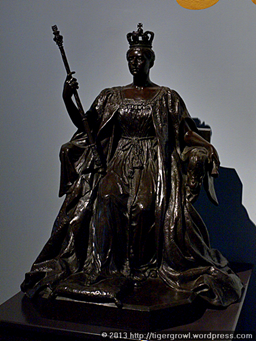

Queen Victoria statue
Sculpted by Princess Louise
When you encounter the small bronze statuette on the left, you might think it one more object acquired by the Royal pair as a gift or as a souvenir bought on their travels. The mystery may deepen, though, when you find the larger scale version in the gardens. The large sculpture came first and the small one later as a model of it. Both were made by Princess Louise (1848-1939), Victoria’s six child and fourth daughter.
Victoria herself shows artistic talent in sketches and paintings made throughout her life and Princess Louise carried this talent to a high degree. In other circumstances, she might have become a practising artist and made a name for herself. Unhappily, such a career was impossible for a Royal princess with ceremonial and other duties though she was allowed to attend the local art school. Louise set up her sculptor’s studio in Kensington Palace where she resided until her death in 1939. She sculpted the large-scale figure in commemoration of Victoria’s Golden Jubilee in 1887 and it was unveiled, in the presence of the Queen, in 1893. It represents a young Victoria in regal pose upon the throne. Is this a unique case of a memorial in honour of a monarch being fashioned by the monarch’s daughter?

The ghost upon the stair…
A projected picture of a young Albert
Though Nottingham House was converted into Kensington Palace in the 17th century for William of Orange and his wife Mary, the state apartments today mainly reflect the taste of the Georgian period in which they were lavishly redecorated. Again, I have picked out a few items that struck me as particularly interesting or beautiful.


The King’s Grand Staircase
Painted by William Kent in 1724
Those admitted to the King’s presence would, after having been vetted by the Royal Guard, have ascended to the state apartments by this, the King’s Grand Staircase. It was painted in 1724 in trompe l’œil style by William Kent. This vast, impressive staircase is lit by a huge hanging lantern no doubt illuminated in its day with candles and later with oil lamps. There are no plain white ceilings here, only intricately painted and moulded ones, works of art in their own right.

Privy Chamber
Queen Caroline entertained here
The state apartments include both public and private rooms. Those lower in the hierarchy gained access only to the outer rooms while the more privileged penetrated further into the inner rooms as they ascended in rank. There is little sense now of the atmosphere of the private rooms but the public spaces were designed to impress and still do so today. This is the Privy Chamber which was one of Queen Caroline’s favourite rooms for entertaining and for holding cultural soirées.
Taking photographs in public areas is a game of seeking and seizing the brief instant when your sightline is free of people. Sometimes the wait is just too long or people wander into the frame as you click the shutter.

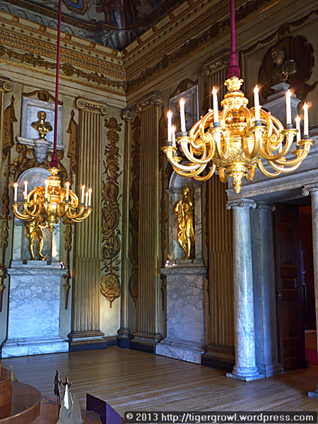
Cupola Room
A glittering setting for dances and entertainments
The Cupola Room, with its gilt chandeliers and statuary, its elaborately painted walls and the dome-shaped ceiling from which it takes its name, is obviously designed to impress visitors with its exuberant display, but it also offered a glittering venue for balls and entertainments.
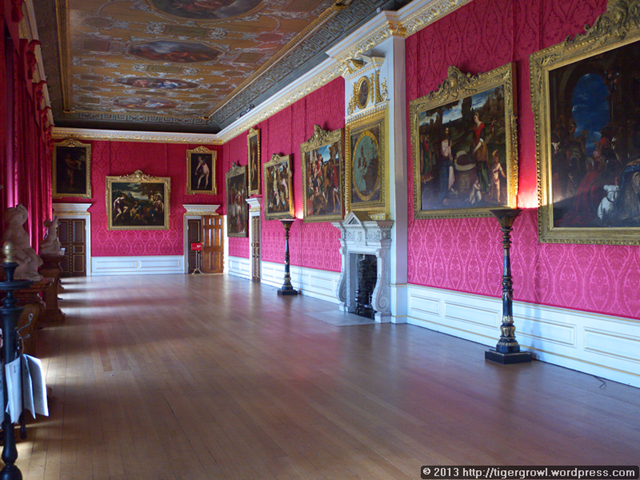
The King’s Gallery
Public and private space?
In the 18th century, the King’s Gallery was hung with paintings by such famous masters as Titian, Rubens and Van Dyke. It is said that the King could be at his ease here with his inner circle, talking freely. Was it then a private or a public space? Perhaps both: a place where friends could meet but also where favoured outsiders could be taken and impressed by the treasure of art on display.


Fireplace with anemoscope
Checking the wind direction
The fireplace seems rather small for such a large and elaborate room. However, its main feature is an anemoscope, or wind dial, showing a map of Britain and Europe, centred on London. This was in place by no later than 1710, during the reign of Queen Anne, and was perhaps installed by the Dutch King, William of Orange. Did he use it to keep watch for when the winds were favourable to sail to or from his native land?

Walkway
An invitation to stroll
Though the palace gardens are now but a shadow of what they once were, they are still beautiful and the shaded walkways invite you to stroll or sit a while on one of the benches.
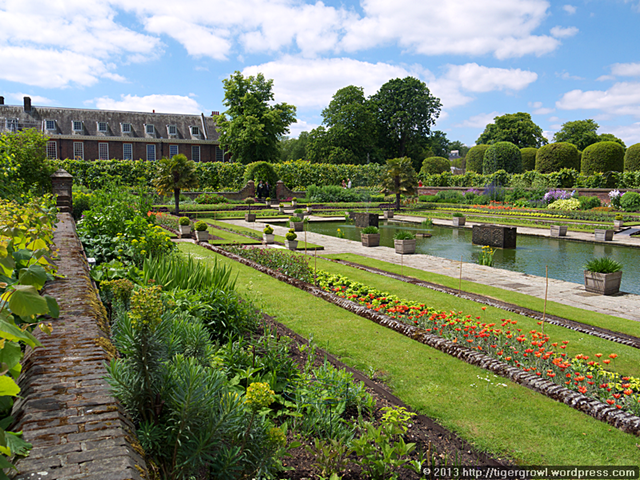
Sunken Garden
Inspired by Dutch designs
The undoubted gem is the sunken garden with its central lake and fountains and its luscious borders of flowers and shrubs. Laid out in 1909 at the instigation of Edward VII, it was inspired by 17th century Dutch gardens. The public are not admitted and one can only glimpse it through gaps in the surrounding hedge. It also finds favour with wildlife and I saw a moorhen grazing contently here.


Albert Memorial
A monument to lost love
We went across to the Royal Albert Hall for a soup and sandwich lunch, passing the Albert Memorial on the way. Designed by Sir George Gilbert Scott in Gothic Revival style, the monument was inaugurated by Queen Victoria in 1872, although the gilded statue of Albert was put in place only two years later. This amazingly intricate and elaborate artwork (you cannot call it anything else) always seizes my attention. I think you either hate it or love it and I love it. It also makes me sad because it is as much a monument to Victoria’s broken heart as it is a memorial to the man she so loved and admired and without whom her life seemed almost no life at all. On a fine sunny day, the precinct becomes crowded with people strolling or sitting, reading or chatting or simply enjoying the place.

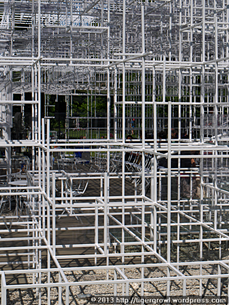
Pavilion at the Serpentine Gallery
2013 pavilion by Sou Fujimoto
After lunch, we went back into the Gardens, to the Serpentine Gallery where we wanted to see this year’s pavilion. Starting in the year 2000, there has been a pavilion every year, except for 2004 when that year’s pavilion failed to materialize. The pavilions are temporary structures and each is made by an invited architect or team that has not so far constructed a building in England. Information on the project can be found on this page which has links to further details. The photos above show a general view of this year’s pavilion and a closer view showing details of construction.
You can go inside the pavilion but for that you need first to obtain a ticket or badge or something and so we didn’t bother. People were also sitting and standing on the outside of it which, if nothing else, argues for it being a solid and safe structure.


Rock on Top of Another Rock
By Peter Fischli and David Weiss
While there, we stopped to admire this sculpture by collaborating artists Peter Fischli and David Weiss. The work bears the prosaic, if accurate, name Rock on Top of Another Rock. I was about to make an ironic comment about the name when it occurred to me that it is far better than some absurdly allusive title that may be explained by thoughts in the artist’s mind but is not reflected in any way in the work itself. However, the sculpture (if we can apply such a term to it) does refer to the Norwegian habit of placing a stone on top of another stone to mark your passage and help retrace your steps later, though whether that justifies it is for each of us to decide for ourselves. I think too that the human mind is always fascinated by rocks stacked on top on one another, whether deliberately (as in Stonehenge) or accidentally in nature (e.g. see the Rocking Stone of Warley Moor).
That was the end of our visit to Kensington Palace and Gardens but we had one more visit to make, having spotted an item of interest from the bus as it passed the end of Grosvenor Crescent.

Drinking fountain 1860
Early example from the Metropolitan Drinking Fountain and Cattle Trough Association
It is this somewhat battered drinking fountain with an unusual clamshell basin (the cups are long gone) and bearing a date of “M.DCCC.LX” (1860). There is no other inscription or dedication visible but it is known that it was installed by the Metropolitan Free Drinking Fountain Association which in 1867 changed its name to the Metropolitan Drinking Fountain and Cattle Trough Association, by which title it is still known. The Association had been formed in 1859 so this fountain, though not its first, is a very early example of its work. (The first was built on Holborn Hill in April 1859.) When this fountain was built, the wall to which it is affixed belonged to St George’s Hospital. Today the site is occupied by the Lanesborough Hotel.
Copyright © 2013 SilverTiger, https://tigergrowl.wordpress.com, All rights reserved.




The infant Peter Pan lived in Kensington Gardens as I recall. They are lovely. They must be doing work on the palace facade, hence the scaffolding. The gates are beautiful. Clothing exhibits are always interesting to me as they allow one to compare the size of the person who wore them to oneself. The Victorians were very sentimental, and morbid as it strikes us today, a carved marble replica of a baby’s little foot or hand would have been just the sort of keepsake they would have treasured, especially considering the infant mortality rate. One recalls Victorian photographs of dead children posed as if they were sleeping which, again, strikes our modern sensibilities as a bit morbid. Or cutting off locks of the deceased hair and embroidering things with them.
LikeLike
You may be right about Peter Pan. I can’t say as I have never read the book.
Clothes (if genuine) do give that extra frisson not possessed by other possessions. They do tend to show that people were generally smaller in the past.
You may be right too about high infant mortality being the reason why parents collected memorabilia of their children (such as model hands and feet and locks of hair) from an early age. Victoria had the best medical care (she was the first woman to be given chloroform to ease the pain of childbirth) and living conditions but would still be affected by the prevailing social customs.
LikeLike
As usual, a stimulating post, Thank you. I have a seemingly rather silly question: were the rooms in the palace interconnected, or were they connected by corridors? This is because I remember reading somewhere that, as you rightly commented, the further you progressed from one room to another, The greater your connexion to the august personage who lived in that particular pile. Corridors were therefore, dare I say it, rather common. The corridor as an expression of democracy – an interesting thought!
As for the Albert Memorial, I have seen and loved it on the several visits I have paid to London. It also made a fitting backdrop to a furtive meeting in one of the films where Michael Caine played the spy Harry Palmer (could it be The Ipcress File?). Its rather shabby, uncared-for, blackened state was a movingly atmospheric metaphor of melancholic, post-war, pre-swinging 60s Britain.
LikeLike
There were some corridors or passages and also series of rooms leading into one another. I didn’t pay close attention and perhaps I should have!
The Albert Memorial is very clean and bright now and makes a colourful show.
LikeLike